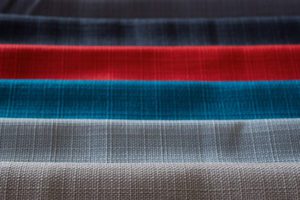
The Negative Environmental Impact of the Fashion Industry and How You Can Help
This Earth Day, learn about the ways the fashion industry hurts the environment and what you can do to reduce your impact
Earth Day is coming up on April 22, and with it comes the opportunity to reflect on how our everyday choices impact the environment. It’s the little things that impact the environment in the biggest ways, and even making small decisions like using reusable bags or choosing to thrift instead of buying things new can have a tremendous effect.
This Earth Day, we want to talk about how fashion impacts the environment. It may come as a surprise to learn that fashion is the second most-polluting industry in the world, trailing only oil and gas production. The good news is that there are many things we can do to reduce our environmental impact when shopping for clothes.
The following are some environmental problems with the fashion industry — along with solutions to minimize your contribution to fashion’s most environmentally harmful practices.
Cotton Farming

One of the most popular fabric materials is cotton. While cotton may seem to be safe since it’s a natural material, there are many hidden drawbacks to its use.
The Problem
Cotton farming is incredibly resource-intensive and polluting. It takes a tremendous amount of water to produce cotton, and the pesticides and herbicides used in cotton production are some of the most harmful to the environment. The agrochemicals used in cotton have been linked to dozens of health problems in humans and animals, including infertility, cancer, and birth defects.
To make matters worse, cotton also requires an immense amount of pesticides: Even though cotton only takes up about 2.5% of the world’s agricultural land, it accounts for up to 16% of insecticides used worldwide. When this is combined with cotton’s heavy irrigation practices, it means that the cotton used to produce clothing like T-shirts and dresses is the result of thousands of gallons of chemical-drenched water being leached into the ground, rivers, oceans, and even drinking water.
The Solution
Although regular cotton is one of the most popular fabrics, there are other options available. If you can’t bear to part with the feel of cotton, you can buy organic cotton whenever possible. Organic cotton is grown without chemical fertilizers, pesticides, or herbicides, making it much more environmentally friendly.
You can also look for clothing made from other natural fabrics like bamboo, hemp, or wool — hemp especially is a lot more water-efficient and doesn’t require nearly as many pesticides, plus organic versions can be found easily.
You can also always choose to buy pre-owned clothes or try repurposing your existing wardrobe.
Synthetic Fabrics

While most agree that natural fabrics are better than synthetic for environmental reasons, many clothes still partially or fully use synthetic materials. Consumer benefits of synthetic materials include stretchiness, durability, and breathability. However, this comes at a cost.
The Problem
The production of polyester, nylon, and other synthetic textiles creates large amounts of toxic pollution, including greenhouse gasses and water contamination. These materials are also non-biodegradable, meaning they will sit in landfills for centuries after you’ve stopped wearing them.
And, to make matters worse, when synthetic fabrics like polyester and nylon get washed or exposed to the elements when they’re thrown away outside, they shed microplastics — which end up in our waterways and eventually in the stomachs of marine life. These microplastics then work their way back up the food chain to us, where they can cause health problems.
The Solution
Although it may be difficult to find completely synthetic-free clothing, you can try to buy items that use less of these synthetic fibers or look for natural alternatives when possible. For example, choose linen instead of polyester or silk instead of nylon. You can also look for clothing made with recycled synthetic materials, which helps to reduce the pollution caused by producing virgin synthetic fabric.
Additionally, be sure to properly wash your synthetic clothes according to the care instructions. This will help them last longer, so you won’t have to throw them away and replace or donate them as quickly.
You can also take steps to reduce the microplastics released from your synthetic fabrics. When you wash them, add a cup of vinegar to the rinse cycle. While this won’t completely stop the microplastic problem, it will help a little bit in preventing shedding.
Fast Fashion

The term “fast fashion” is used to describe clothing that is produced quickly and cheaply in order to keep up with the latest trends. Unfortunately, this comes at a huge cost to the environment.
The Problem
The clothing industry is responsible for about 20% of the world’s water pollution, and much of this can be traced back to fast fashion. The dyeing and finishing of textiles is a very water-intensive process, and the manufacturing of synthetic fabrics like polyester requires even more resources.
To make matters worse, the factories in which fast fashion is manufactured are often in developing countries, where environmental regulations are lax or non-existent. This means that factories can pollute the air and water without any repercussions, which they frequently do with the toxic chemicals used in dyeing and processing. They also pay their workers low wages and expose them to dangerous and harsh working conditions.
From the consumer side, fast fashion encourages people to buy clothes more often, which leads to mountains of clothing waste for clothes that were only worn once, twice, or not at all. The average American throws away 80 pounds of textile waste each year, and it’s estimated that the global fashion industry will produce 111 million metric tons of carbon dioxide emissions by 2030.
The Solution
As with most environmentally friendly choices, the best way to reduce your impact from fast fashion is to buy less of it. Try reusing your old clothes and creating a wardrobe that can use the same few pieces for lots of different outfits, so you don’t feel compelled to buy a brand new outfit for an event. You should also make sure to properly care for your clothes so they last longer. This includes washing them less often and in cold water.
If you do need to buy new clothes, try to find ones that are made from sustainable materials like natural, organicl fabrics or recycled polyester. You can also look for clothing that is Fair Trade Certified, which means the workers who produced it were treated fairly and compensated adequately. You can also try shopping secondhand or at consignment stores, which will help keep clothes out of landfills.
The Bottom Line: Reusing Is Always Better
While buying sustainably made clothing that uses organic, fair trade, or recycled materials is good, the best solution to fighting the environmental impact of the fashion industry is to avoid buying new clothes at all. As the popular saying goes, “The most sustainable product is the one you already have.”
Taking care of your existing clothes and making sure you can keep re-wearing them for years to come is a vital part of positively impacting the environment. And if you absolutely need to buy new clothes, a consignment or thrift store like ThriftSmart is always a better choice than even the most sustainable new product.
If you’re looking to revitalize your wardrobe the eco-friendly way, visit ThriftSmart and check out our wide selection of clothes and accessories today.




Sorry, the comment form is closed at this time.